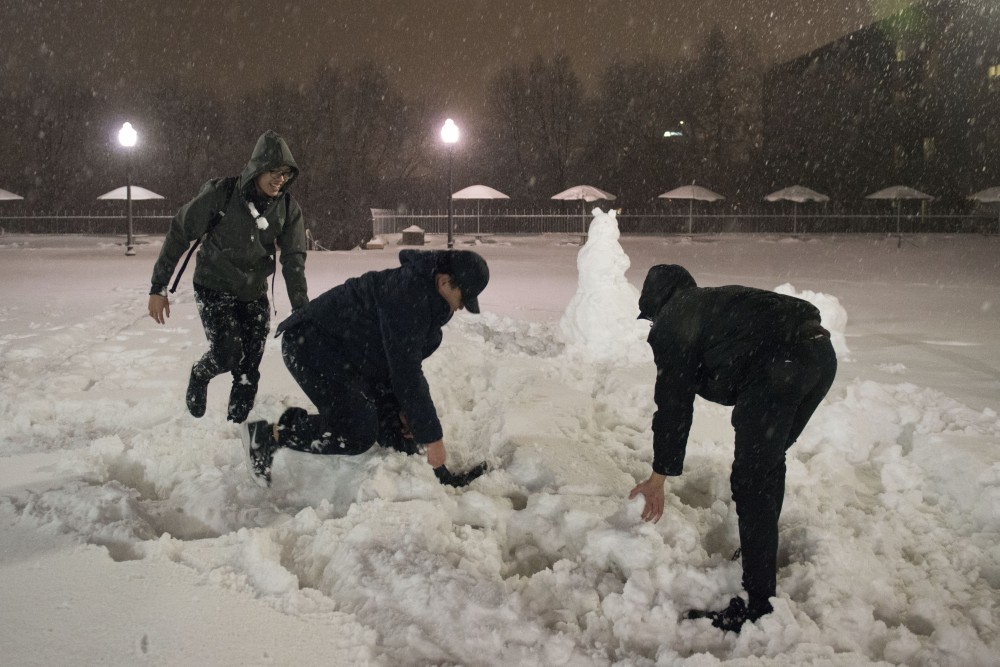After a night of heavy snowfall, Steven Blodgett goes out at 5 a.m. to plow snow around the University of Minnesota campus. On a snowy day, Blodgett said he can be out working until around 5 p.m.
A gardener for University Landcare, Blodgett is among those who have been working overtime to clear snow from roads and sidewalks, keeping the University running throughout the winter. But Blodgett said he is getting tired as snow continues to fall into March after a record-breaking snowfall in February.
Along with Blodgett, the University is struggling to keep up with the snow. University Landcare is having trouble keeping enough student workers this winter and is having to find alternative places to store the snow plowed on campus.
On Sunday, Daniel Bereketab, a custodian at the University, was out shoveling snow on the steps of Pillsbury Hall. Custodians normally do not clear snow, but Bereketab said he was offered overtime pay to shovel following a heavy snowfall Saturday night.
Some places in the Twin Cities area received over six inches of snow Saturday evening, adding to the record-breaking 39 inches that accumulated in February. The University is having to find new places to store snow as the Minnesota State Fairgrounds, its typical storage site, is likely to hit capacity after the snowfall over the weekend.

Tom Ritzer, assistant director for University Landcare, said it is not easy finding storage locations near the University due to land around campus becoming more developed and getting more expensive to use.
This is not the first year the University has reached its storage capacity, Ritzer said. After heavy snowfall in April last year, the University had to use parking lots in the Como neighborhood for storage.
On snowy days, a full-time employee for University Landcare will clock in around 5 a.m. and work a 12-hour day. Blodgett said some employees will stay later into the night to keep routes to the hospital and sporting events plowed.
Even a couple days after a snowfall, workers will still be out clearing up and salting roads and sidewalks.
“I am concerned about my employees; it has been a tough winter on them,” Ritzer said. “A lot of them have young kids. They are not able to spend as much time with their families as they normally would.”
Shortage of students
In part because of the early and long hours, University Landcare is struggling to keep enough student workers. These workers shovel snow on stairs and around fire hydrants. They also ensure sidewalks are wheelchair-accessible.
“They are an important part of our team for campus safety and accessibility,” Ritzer said.
There are currently around 30 students working in the department. Ritzer said they usually have around 50 student employees.
While the numbers are down this year, retaining students and getting them to show up on time in the morning has always been an issue, said David Deiman, a former University student and former University Landcare employee.
Consistently clearing campus
Despite the challenges University Landcare is facing, students say the University does a good job clearing snow around campus.
“The University has been doing better than most places,” said first-year student Drew Potthast as he walked around a freshly plowed campus Sunday morning. “The sidewalks are typically worse in Dinkytown.”
Deiman said the University is able to remove snow faster than the City can in the neighborhoods surrounding campus because University employees have less ground to cover.
While University workers try to clear most of the snow before people arrive on campus, they continue removing snow throughout the day. This can sometimes be problematic when campus is full of students walking to class.
There are instances when students are in a hurry and run in front of a snow plow. Sometimes students are on their phones and do not notice if they are in the way of a plow. Blodgett said this is dangerous and could cause an accident.
“We are watching out for you; please watch out for us,” Blodgett said. “We are around trying to keep everything open and safe and accessible; just let us do what we do.”









